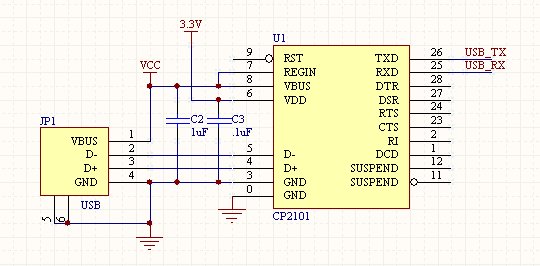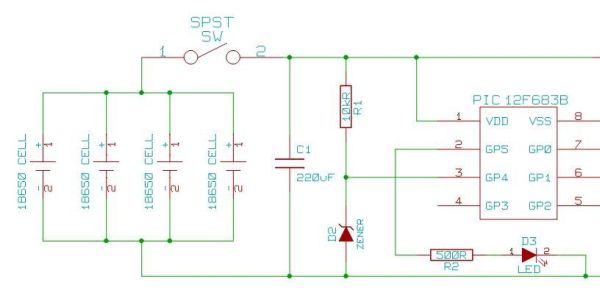
GPS USB Dev Board

The CP210x USB ICs from Silicon Labs are commonly used in various applications. The CP2102 model provides a 3V TTL to a Virtual COM Port (VCP) over USB and generates the necessary 3.3V for the board. It is important to note that this setup lacks ESD protection and surge suppression, which may lead to potential violations of USB standards. However, it is functional. When configured in this manner, the CP2102 can supply up to 100mA at 3.3V through its internal voltage regulator, which is suitable for applications like the PG31 that requires approximately 40mA at 3.3V. The CP2102 features an integrated crystal and EEPROM, minimizing the need for external components. Users have the ability to program a custom ID string, allowing the device to be recognized by its designated name when connected to a computer. Upon connection, the Windows hardware wizard will prompt for driver installation, which can be obtained from Silicon Labs. Custom drivers can also be created using software from Silicon Labs. Once the drivers are installed, the CP210x will function as a serial COM port, enabling seamless communication over USB without the need for complex drivers or protocols. It is noteworthy that while Silicon Labs has provided strong support for Windows, the Linux community may face challenges due to limited driver availability. The CP2102 is only available in a QFN leadless package, which can be hand-soldered with experience and proper tools, although excessive heat can damage the PCB. For applications involving GPS, a battery backup is essential. A 12mm coin cell lithium battery allows devices like the PG31 to retain almanac data, enabling faster warm locks rather than cold locks. The battery provides sufficient power for 3-5 years. It is important to ensure proper contact between the battery and the PCB, as the concave bottom of the cell may affect connectivity.
The CP2102 USB to UART bridge is an efficient solution for converting USB signals to TTL serial communication. The device supports data rates up to 1 Mbps and can be used in various applications such as microcontroller programming, GPS modules, and other serial devices. The internal voltage regulator is a significant advantage, allowing the CP2102 to power peripheral devices directly without requiring an external power supply.
The EEPROM integrated within the CP2102 can be programmed to store custom configurations, including product IDs and serial numbers, which enhances the device's usability in commercial applications. The programming process can be accomplished through a simple interface provided in the Silicon Labs software suite, which simplifies the development process for engineers.
In terms of design considerations, it is crucial to implement ESD protection and surge suppression in the final circuit design to comply with USB standards and ensure the longevity of the device. Although the CP210x series is primarily designed for Windows environments, there have been developments in Linux driver support, particularly for the CP2102, which may facilitate broader application use.
The QFN package, while compact, necessitates careful handling during soldering. Proper heat management and technique are essential to avoid damaging the PCB or the IC itself. For engineers not familiar with SMD components, it is advisable to practice soldering techniques on scrap boards before working on final designs.
In applications requiring GPS functionality, including a battery backup is vital for maintaining critical data. The 12mm lithium coin cell is a popular choice due to its size and capacity. It is important to design the PCB with a proper footprint for the coin cell holder, ensuring that the battery makes reliable contact with the ground pad to prevent intermittent connections.
Overall, the CP2102 offers a versatile and efficient solution for USB to serial communication, with extensive features that cater to a wide range of electronic applications. Proper design practices and attention to detail will enhance the performance and reliability of circuits utilizing this IC.You`ve probably heard about the CP210x USB ICs from Silicon Labs, now here`s an application that uses it. The CP2102 gives us 3V TTL to a VCP (virtual comm port) over USB as well as generating the 3. 3V needed for the board. There are a couple things to note. In this setup, we do not have any ESD protection or surge supression. We are quite possibly violating some USB standards. But does it work Yep. When you configure the CP2102 this way, it can source up to 100mA at 3. 3V using its internal voltage regulator. This is perfect for our application as the PG31 needs ~40mA at 3. 3V. The CP2102 has built-in cystal and eeprom. These means you need very few external components to get it working. You can even program in your own ID string so when you plug it onto your computer, it comes up with the name of your widget! When the CP210x is attached to a computer (and it`s soldered correctly) you will see windows hardware wizard request drivers.
These drivers can be downloaded from SI Labs. You can also create your own signature drivers using some SI Labs software. You can also program the internal EEPROM to reflect your own product ID and serial strings. This software is from SI Labs as well but I forget were - when someone finds it, post it here. Once the drivers are installed, the CP210x will turn into a serial com port! Yes! It`s weird to think about until you see it happen. So this USB dev board now acts like a com port on my computer. All I have to do is pass characters in and out COM 5 (for example) and I can do things over USB! No messy drivers, no protocols to think about, it`s all done in the IC. All right! One thing to note when you are using the CP210x ICs, the Linux community may scoff. SI Labs did a great job with the windows support, but a piss-poor job of opening the drivers for the open-source community. I`m not really a Linux person so it didn`t effect me. But if your app needs linux connectivity, you may want to take a quick look for other potential ICs. Last I heard, there was good Linux support for the CP2102, but there was nothing for the CP2103 GPIO control.
One last con: The ICs come in QFN leadless package only. YES it can be soldered by hand, but you`ll need some experience and/or some good hot-air soldering tools. I taught myself how to rework stuff using this IC. You really can`t destroy it, but you can certainly delaminate (kill) the PCB if you heat it for excessive amounts of time.
Don`t `not` create a PCB or a design because of silly SMD parts. They`re not that hard to solder! If you`re playing with GPS, you`ve got to have a battery backup. The 12mm coin cell lithium allows the PG31 (and many other GPS receivers) to retain the alamanac data. This small battery provides just enough juice for 3-5 years. By having alamanac data at power on, the GPS receiver will be able to do a warm lock instead of a cold lock.
Cold locks take 1-2 minutes, warm locks, as little as 30 seconds. The alamanac data, in effect, allows the GPS receiver to `guess` where it is in the world ("Last time I was on I was in Ohio, therefor, I will assume I`m near there"). If you`re unfamiliar with Lithium Coin Cells - they come in a couple different sizes. I prefer 12mm just cause it`s small but beefy enough to do most of the BBR (battery backed ram) that we need to support.
The battery itself has a postive top (noted by the plus) and a ground on the bottom. You normally create a pad on the PCB for the ground and the coin cell holder is positive. We`ve learned the hard way that the bottom part of the cell is sometimes concave. This means that when you slide the coin cell onto the board, the concave ground part of the cell may not contact the PCB pad very well. If you`re using a paste stencil, just leave a cutout for this pad. The extra paste will add 5-10 mils of solder to the pad. If you`re solder the thing by hand, add a little blob of solder to this ground pad to give it som 🔗 External reference
The CP2102 USB to UART bridge is an efficient solution for converting USB signals to TTL serial communication. The device supports data rates up to 1 Mbps and can be used in various applications such as microcontroller programming, GPS modules, and other serial devices. The internal voltage regulator is a significant advantage, allowing the CP2102 to power peripheral devices directly without requiring an external power supply.
The EEPROM integrated within the CP2102 can be programmed to store custom configurations, including product IDs and serial numbers, which enhances the device's usability in commercial applications. The programming process can be accomplished through a simple interface provided in the Silicon Labs software suite, which simplifies the development process for engineers.
In terms of design considerations, it is crucial to implement ESD protection and surge suppression in the final circuit design to comply with USB standards and ensure the longevity of the device. Although the CP210x series is primarily designed for Windows environments, there have been developments in Linux driver support, particularly for the CP2102, which may facilitate broader application use.
The QFN package, while compact, necessitates careful handling during soldering. Proper heat management and technique are essential to avoid damaging the PCB or the IC itself. For engineers not familiar with SMD components, it is advisable to practice soldering techniques on scrap boards before working on final designs.
In applications requiring GPS functionality, including a battery backup is vital for maintaining critical data. The 12mm lithium coin cell is a popular choice due to its size and capacity. It is important to design the PCB with a proper footprint for the coin cell holder, ensuring that the battery makes reliable contact with the ground pad to prevent intermittent connections.
Overall, the CP2102 offers a versatile and efficient solution for USB to serial communication, with extensive features that cater to a wide range of electronic applications. Proper design practices and attention to detail will enhance the performance and reliability of circuits utilizing this IC.You`ve probably heard about the CP210x USB ICs from Silicon Labs, now here`s an application that uses it. The CP2102 gives us 3V TTL to a VCP (virtual comm port) over USB as well as generating the 3. 3V needed for the board. There are a couple things to note. In this setup, we do not have any ESD protection or surge supression. We are quite possibly violating some USB standards. But does it work Yep. When you configure the CP2102 this way, it can source up to 100mA at 3. 3V using its internal voltage regulator. This is perfect for our application as the PG31 needs ~40mA at 3. 3V. The CP2102 has built-in cystal and eeprom. These means you need very few external components to get it working. You can even program in your own ID string so when you plug it onto your computer, it comes up with the name of your widget! When the CP210x is attached to a computer (and it`s soldered correctly) you will see windows hardware wizard request drivers.
These drivers can be downloaded from SI Labs. You can also create your own signature drivers using some SI Labs software. You can also program the internal EEPROM to reflect your own product ID and serial strings. This software is from SI Labs as well but I forget were - when someone finds it, post it here. Once the drivers are installed, the CP210x will turn into a serial com port! Yes! It`s weird to think about until you see it happen. So this USB dev board now acts like a com port on my computer. All I have to do is pass characters in and out COM 5 (for example) and I can do things over USB! No messy drivers, no protocols to think about, it`s all done in the IC. All right! One thing to note when you are using the CP210x ICs, the Linux community may scoff. SI Labs did a great job with the windows support, but a piss-poor job of opening the drivers for the open-source community. I`m not really a Linux person so it didn`t effect me. But if your app needs linux connectivity, you may want to take a quick look for other potential ICs. Last I heard, there was good Linux support for the CP2102, but there was nothing for the CP2103 GPIO control.
One last con: The ICs come in QFN leadless package only. YES it can be soldered by hand, but you`ll need some experience and/or some good hot-air soldering tools. I taught myself how to rework stuff using this IC. You really can`t destroy it, but you can certainly delaminate (kill) the PCB if you heat it for excessive amounts of time.
Don`t `not` create a PCB or a design because of silly SMD parts. They`re not that hard to solder! If you`re playing with GPS, you`ve got to have a battery backup. The 12mm coin cell lithium allows the PG31 (and many other GPS receivers) to retain the alamanac data. This small battery provides just enough juice for 3-5 years. By having alamanac data at power on, the GPS receiver will be able to do a warm lock instead of a cold lock.
Cold locks take 1-2 minutes, warm locks, as little as 30 seconds. The alamanac data, in effect, allows the GPS receiver to `guess` where it is in the world ("Last time I was on I was in Ohio, therefor, I will assume I`m near there"). If you`re unfamiliar with Lithium Coin Cells - they come in a couple different sizes. I prefer 12mm just cause it`s small but beefy enough to do most of the BBR (battery backed ram) that we need to support.
The battery itself has a postive top (noted by the plus) and a ground on the bottom. You normally create a pad on the PCB for the ground and the coin cell holder is positive. We`ve learned the hard way that the bottom part of the cell is sometimes concave. This means that when you slide the coin cell onto the board, the concave ground part of the cell may not contact the PCB pad very well. If you`re using a paste stencil, just leave a cutout for this pad. The extra paste will add 5-10 mils of solder to the pad. If you`re solder the thing by hand, add a little blob of solder to this ground pad to give it som 🔗 External reference





